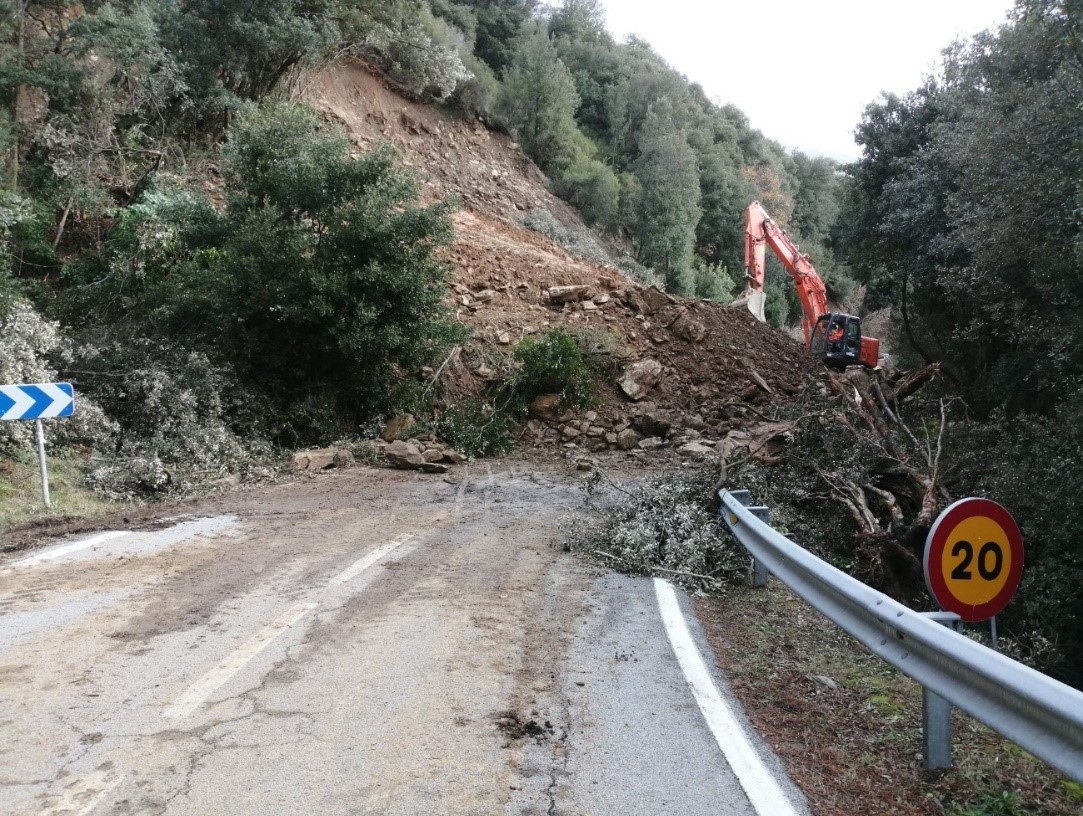MORLEs in the Pyrenees
Multiple landslides, also known as MORLEs (Multiple Ocurrance of Regional Landslide Events), correspond to the simultaneous appearance of a large number of surface landslides after episodes of heavy rainfall that affect large areas of the territory (Figure 1) (Crozier, 2005).
Figure 1. MORLEs developed in Wanganui-Manawatu, North Island, New Zealand between the 15th and 17th of February 2004, photo: Graham Hancox (Crozier 2005).
The area affected by MORLEs can vary from hundreds to thousands of square kilometres, depending on the spatial extent of the triggering rainfall. The management of risk associated to MORLEs is highly conditioned by the multiple nature of these events and their simultaneity with the risk of floods that affect basic services, infrastructures and roads and limit the capacity of intervention from the rescue services. The extensive damage to people, properties, infrastructures and activities caused by MORLEs also raises the issue of the post-crisis resilience of the territory. In this context, risk reduction related to MORLEs is essentially based on multiple event time prediction and crisis scenario simulation. This requires establishing correlations between the characteristics of the triggering rainfall and the occurrence of MORLEs in areas with different geological and hydrographic contexts.
The Biescas disaster (Huesca, Spain) is a clear example of the potential for damage of MORLEs in the Pyrenees. The debris flooding that occurred in Biescas on the 7th of August 1996 was triggered by a very intense and short-lived rain event (approximately 150 mm/h in 30 minutes) in a small drainage basin (19km2) (Riosalido, 1996) . The sudden flood loaded with sediments reached the alluvial fan fed by the Arás gorge in the Gállego´s river valley and devastated the Nieves campsite (Figure 2), causing 87 deaths and leaving 187 people injured (Ayala, 2002). The high sediment load of the debris flooding was related to the failure of numerous dams in the Arás gorge.
Figure 2. On the left, front page of the newspaper "El País" after the Biescas disaster (08/08/1996), on the right, a photograph of the "Las Nieves" campsite devastated.
The Pyrenees are known to experience catastrophic MORLEs crises approximately every 30 to 40 years, however crises of lower magnitude may happen at shorter intervals of time. During the 20th century, various MORLEs events occurred in conjunction with extreme floods:
-
Molló-Queralbs (October 1940): The so-called “Aiguat de 1940” was an episode of torrential rains that took place between the 16th and the 20th of October 1940 in the eastern sector of the Pyrenees, affecting both the northern French slope and the south and causing devastating floods. The basins affected were mainly those of the Ter, Muga and Fluvià rivers on the southern slope and those of the Tec, Tet and Agli on the northern slope. The episode on the French side was described by Pardé (1941) and later, in much more detail, by Soutadé (1993). Officially, 840 mm of rain were recorded only counting on October the 17th, a record that reaches the maximum precipitation recorded in Europe in 24 hours, and it is estimated that the flood of the Tet river in Perpignan reached 3000 m3/s (Soutadé, 1993 ). The number of victims reached 350 deaths, 60 of which belonged to the population of Torelló in the Ter river basin.
Simultanously to the rains, hundreds of landslies occurred on the mountain slopes, especially around the Canigó massif, on the northern slope. The slopes covered with colluvium material and morrenic deposits were practically dismantled by debris currents ("xalades" in local terminology) (Figure 3a).
Figure 3. a) Landslide of morrenic deposits in the Cortalets basin triggered by the events of October 1940 and 1970 at the Canigó massif (France) and the vicinity of Vernet-les-Bains b) before and c) after the downpour of 1940. Formation of block bars and gravels and widening of the river bed (braided regime). (Source: Portilla, M. 2014).
The large amount of sediment dragged by the ravines reached the inhabited areas located downstream generating significant alluvial deposits such as those observed in the town of Vernet-les-Bains (Figures 3b and 3c).
- Barruera-Vielha (August 1963): The rainy episode of August 1963 lasted more than a week and the heaviest rains were recorded on Saturday the 3rd and repeated on the 5th. The area of impact extended mainly through the Central Pyrenees, including the upper basins of the Garonne River, the Noguera Ribagorçana and the Esera River. Despite the notable economic consequences in these regions the information available about the event is inaccurate and incomplete. In addition, the low density of existing weather stations in the region is an added difficulty in the face of the reconstruction of the landslide episode.
In particular, in the Barruera-Vielha sector an important part of the landslised occurred on moraine deposits located several hundred meters above the bottom of the valleys (Figure 4). The infiltration of rainwater within the morrenic deposits together with the surface erosion led to the formation of rotational landslides and their channeling as drag currents.
Figure 4. Detail of a moraine deposit in Erill-la-Vall (Photo: J.Corominas, Source: Portilla, M. 2014)
For the inventory of landslides associated with the rainy event, the interpretation of the 1975 aerial photographs was carried out, which were later corrected with the aerial photographs of the Army Geographical Service (1956-1957); the scars that already existed in these last photos, or the extension of the scars that did not coincide with the one observed in the photographs of 1975, were discarded as generated by the rains of 1963. The inventory was finally conformed by 105 shallow landslides distributed over an area of 504 km2.
- Berga-Cercs (June 2008): The rains that took place in the area of Berga-Cercs between May 31st and June 6th, 2008 generated multiple shalow landslides (Figure 5a) and at least two earth flows, one of which led to the interruption of the C-16 road at the northern portal of the Berga tunnel (Agència Catalana de Notícies, 2008) (Figure 5b).
Figura 5. a) Shalow landslides on the old Berga-Cercs road, and b) earth flow blocking the north portal of the Berga tunnel (Photos: J. Corominas, June 7, 2008, Source: Portilla, M. 2014).
- Gloria storm (January 2020): The Gloria storm occurred from the 19th to the 21st of January 2020, being the hardest and most exceptional storm that Spain and south of France have suffered since the episode of January 1982. In the entire Spanish state the storm left a total of fourteen dead, 83 injured people and large material losses (only in the Maresme area more than 40 million euros of losses were estimated. For instance, two bridges of the Tordera River were demolished in Malgrat de Mar). The strong waves and the heavy rainfall (> 400 l / m2 in the Montseny area), were the main phenomena triggering the torrential floods and slope movements registered in the country. During the storm, numerous incidents caused by landslides (of different types and magnitudes) were invented, such as the landslise that cut off for days the BV-5301 road to access the municipality of the Montseny (where about 17 people live) (Figure 6).

Figure 6. Mud and debris flux cutting kilometer 17.5 of the BV-5301 road (Montseny, eastern Vallès). The Catalan Government invested more than half a million euros in stabilizing the slopes of this road. (Source: ICGC).
The effects of the Gloria storm had a prolonged effect over time. In particular, the saturation of the aquifers during the storm favored, months after, the occurrence of multiple landslides due to torrential rains (Figure 7).
Figure 7. a) Pavement breakage in Calle de la Mosca, Calabuig Bàscara (Source: Bàscara Town Hall) and b) cutt off of the BV-2041 road (Begues) due to landslides triggered by intense rains on the 21st-22nd of April 2020 (Source: ICGC)
For more information about MORLEs in the Pyrenees, check the monograph on historical MORLEs (in preparation).

